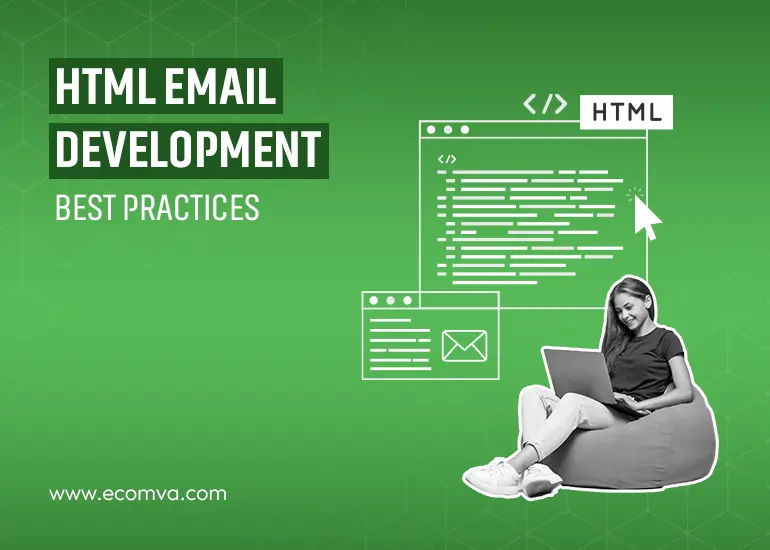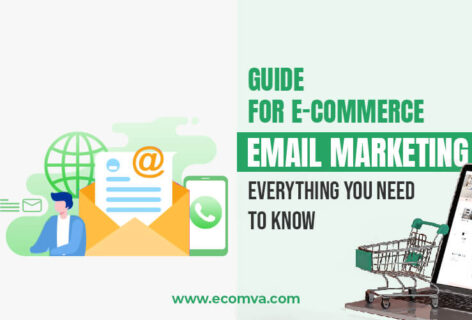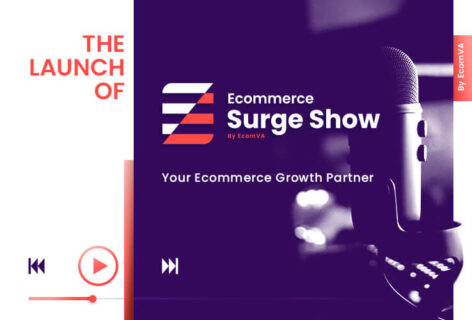Best Practices for Crafting HTML Email Development

Did you know that email marketing yields an impressive ROI of $42 for every $1 spent? Furthermore, emails have a global reach with over 4 billion daily users. With stats like these, it’s clear that email is not just surviving but thriving. However, success in email marketing requires more than just sending out bulk emails; it demands strategic design, development, and execution.
In this blog post, we are going to discuss the best practices for HTML email development, helping you craft emails that not only capture attention but also drive conversions. So, let’s delve in:
Understanding the Basics of HTML Email
HTML emails are more than just plain text messages; these are visually rich, engaging, and interactive. Due to this reason, these are regarded as a vital component of modern email marketing design. HTML typically lets you incorporate buttons, images, and other design elements to enhance your message and boosting engagement. However, the versatility of HTML also means that developers must pay close attention to how emails render across distinct devices and email clients.
One of the integral aspects of email development involves making sure that your emails are responsive. Responsive email design facilitates making sure that your emails look great and function well on any device, whether your audience is viewing them on a desktop, tablet, or smartphone. This is particularly important as mobile devices account for nearly 46 percent of all email opens. Failing to optimize for mobile could mean missing out on a significant portion of your audience.
What are the Email Development Best Practices that One Should Follow?
For crafting a successful email marketing campaign, it is crucial to make sure that the design of your emails is both functional and eye-striking. Below are a few best practices that you should focus on following:
1. Make Sure to Keep It Simple and Focused:
Maintaining simplicity is highly important in the case of email design. A cluttered email will end up leaving your reader overwhelmed, which can eventually lead to lower engagement rates. Also, it is important to stick to a single-column layout, as it is incredibly easier to read. Not only that, but it also ensures compatibility, especially across devices.
2. Utilize a Clear Hierarchy:
Another important thing is to focus on organizing your content with the aid of a clear visual hierarchy. To make your content skimmable, you can make use of subheadings, headings, and bullet points. Also, you should make sure to place all the vital pieces of information at the top of the email.
3. Incorporate Visuals Thoughtfully:
While adding visuals can work towards enhancing your email, you should make sure to use those judiciously. Adding large images can cause slowing down of load times, especially on mobile devices. You should also make sure that all images are well optimized for fast loading and always include alt text if the images fail to load.
4. Don’t Miss Adding a Strong CTA or Call to Action:
You should design your email with a clear as well as compelling CTA that drives the reader to take specific action. Whether it is making a purchase, tapping on a link or signing up for a webinar, the CTA should be effortless to find and stand out visually.
5. Optimize for Dark Mode:
With the rising recognition of dark mode on different devices, it becomes vital to make sure that your email design works well in both light as well as dark modes. So, in this regard, you should focus on testing your emails to see how they look in dark mode and make necessary adjustments. This way, you would be able to ensure readability.
6. Test across Devices and Platforms:
As email clients render HTML differently, and so, it is highly important to test your emails across different devices and platforms. It typically incorporates testing for various screen sizes, operating systems, and email clients to ensure a consistent experience for every user.
Crafting Engaging Email Content: Key Tips to Follow
Content is the king in email marketing. No matter how well-designed your email is, it will fall flat if the content fails to resonate with your audience. Here are a few outstanding tips that you should focus on following for crafting compelling email content:
- Personalization: Do you know that tailored emails are known for delivering six times higher transaction rates? So, it becomes important for you to leverage data effectively to segment your audience as well as deliver personalized content that speaks directly to their unique requirements and interests.
- Value Proposition: You should also clearly communicate the value of your email to the reader. Whether it is a special offer, valuable information, or an important update, the reader should instantly get an idea about why the email is worth their time.
- Concise Messaging: It is always a good idea to get to the point quickly. People often skim through emails, so it is vital to make sure that your message is both clear and concise. You should make use of short sentences as well as paragraphs for conveying your message in an effective manner.
- Engaging Subject Lines: The subject line is the first thing your audience sees, and it plays a big role in determining whether your email gets opened. You should focus on crafting subject lines that are pertinent, intriguing, and aligned with your email’s content.
- Interactive Elements: By incorporating interactive elements such as polls, surveys or clickable images, you would be able to boost engagement. Interactive content helps in capturing attention along with persuading readers to take action within the email itself.
Email Testing and Optimization
Before you hit the send button, it is vital to carry out proper testing and optimization of your emails. Here is how you can make sure that your emails perform at their best:
- A/B Testing: A/B testing typically entails sending two versions of an email to a small segment of your audience to determine which one performs better. You can focus on carrying out testing of different elements which includes CTAs, subject lines, images, and content to see what resonates most with your audience.
- Load Time Optimization: You should make sure that your email loads swiftly, especially on mobile devices. As a part of it, you need to compress images, minimize the usage of heavy graphics, and avoid unnecessary code to reduce load times.
- Analytics and Reporting: Finally, you should make use of analytics tools for tracking the performance of your emails. Also, it is important to monitor key metrics which include click-through rates, open rates, and conversions. This way, you can get an idea about what is working and what necessitates improvement. You can leverage this data to refine future email campaigns.
Email Accessibility
It is vital to make sure that your emails are accessible to everyone, which also includes people with disabilities. Let’s find out how you can do this:
- Use Alt Text: You should always focus on including alt text for images.
- Logical Reading Order: It is vital to make sure that the content flows logically for screen readers.
- Sufficient Contrast: You should aim to provide enough contrast, especially between text as well as background to ensure readability.
Digging into Details about Email Marketing Tools and Resources
By using the appropriate tools and resources, you would be able to effectively streamline your email development procedure along with improving your campaigns. Below are given a few recommended tools:
- Best Email Marketing Platforms: There are the availability of certain platforms such as HubSpot, Mailchimp and Constant Contact. These tend to offer robust features that assist in crafting, sending, and evaluating email campaigns. Also, these platforms are involved in providing automation, templates and analytics to help you manage your email marketing services effectively.
- Email Automation Services: Automation tools such as ActiveCampaign and Klaviyo let you set up automated email sequences that help in engaging your audience at the appropriate time. With automation, you would be able to effectively save time while also ensuring consistent communication with your subscribers.
- Email Testing Tools: You will find the availability of tools like Litmus and Email on Acid. These specific tools are known for offering comprehensive testing environments to see how your emails render across various devices as well as email clients. These even offer insights into potential issues and best ways to fix those.
- Responsive Email Design Tools: By employing tools such as Foundation for Emails or MJML, you would be able to craft responsive email designs that effectively adapt to any screen size. These tools facilitate easing out the process of coding responsive emails along with ensuring consistency across devices.
Wrapping Up
Thus, HTML email development is considered to be a critical component of any thriving email marketing strategy. By following best practices in email design, crafting engaging content, and leveraging the right tools, you would be able to craft emails that not only capture attention but also drive conversions.
Remember, each element of your email contributes to its overall effectiveness. So, you should take the time to refine your strategy, utilize the right tools, and stay updated with the latest trends.










